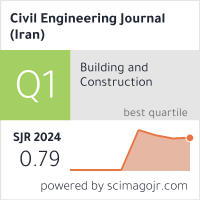The Effects of Spillway Width on Outflow Discharge and Flow Elevation for the Probable Maximum Flood (PMF)
Downloads
Doi:10.28991/CEJ-2022-08-04-08
Full Text:PDF
Downloads
[2] Anggara, W. W. S., & Sundary, N. (2017). Cacaban Reservoir Volume Change Study with Reservoir Publication Survey. Jurnal Teknik Pengairan: Journal of Water Resources Engineering, 7(2), 310-315. (In Indonesian).
[3] Sutopo Y. (2019). Effect of Spillway Effective Width on Flow Elevation above the Lighthouse and Minimum Cost of Cacaban Dam Renovation. Thesis, Penelitian Unggulan Perguruan Tinggi Unnes, Semarang, Semarang, Indonesia. (In Indonesian).
[4] Hossain, M. M. (2015). Analysis of Flood Routing. Dhaka University Journal of Science, 62(2), 69–73. doi:10.3329/dujs.v62i2.21968.
[5] Ionescu, C. S., & Gogoaşe Nistoran, D. E. (2019). Influence of reservoir shape upon the choice of Hydraulic vs. Hydrologic reservoir routing method. E3S Web of Conferences, 85, 1–8. doi:10.1051/e3sconf/20198507001.
[6] Sutapa, I. W. (2019). Study flood routing Mamak Dam and evaluate the River Mamak to convey the flood design, Lombok, Indonesia. IOP Conference Series: Materials Science and Engineering, 673(1), 1–9. doi:10.1088/1757-899X/673/1/012035.
[7] Asmaranto, R., Priyantoro, D., Rini, D. Y., & Aini, A. K. (2020). Safety evaluation of the existing Grawan dam based on hydro-geotechnical behaviour conditions to ensure the availability of water resources. IOP Conference Series: Earth and Environmental Science (Vol. 437, No. 1, p. 012006). IOP Publishing. doi:10.1088/1755-1315/437/1/012006.
[8] Feng, M., & Liu, P. (2014). Spillways Scheduling for Flood Control of Three Gorges Reservoir Using Mixed Integer Linear Programming Model. Mathematical Problems in Engineering, 1–9. doi:10.1155/2014/921767.
[9] Karim, I. R., Hassan, Z. F., Abdullah, H. H., & Alwan, I. A. (2021). 2D-Hec-Ras Modeling of Flood Wave Propagation in a Semi-Arid Area Due To Dam Overtopping Failure. Civil Engineering Journal, 7(9), 1501–1514. doi:10.28991/cej-2021-03091739.
[10] NAJAR, M., & GíœL, A. (2022). Investigating the Influence of Dam-Breach Parameters on Dam-Break Connected Flood Hydrograph. Teknik Dergi, 33, 1–24. doi:10.18400/tekderg.796334.
[11] Al Islam, M., & Hasan, H. (2020). Generation of IDF equation from catchment delineation using GIS. Civil Engineering Journal, 6(3), 540–547. doi:10.28991/cej-2020-03091490.
[12] Desa M., M. N., & Rakhecha, P. R. (2007). Probable maximum precipitation for 24-h duration over an equatorial region: Part 2-Johor, Malaysia. Atmospheric Research, 84(1), 84–90. doi:10.1016/j.atmosres.2006.06.005.
[13] Kim, N. W., & Lee, J. (2017). Estimation of time-variant probable maximum precipitation for South Korea. KSCE Journal of Civil Engineering, 21(3), 1031–1038. doi:10.1007/s12205-016-1052-x.
[14] Sibuea, P. R., Agriamah, D. R., Riawan, E., Suwarman, R., & Lubis, A. (2021, November). Estimation of Probable Maximum Precipitation (PMP) and Probable Maximum Flood (PMF) Using GSSHA Model (Case Study Area Upper Citarum Watershed). IOP Conference Series: Earth and Environmental Science, 893(1), 012023. doi:10.1088/1755-1315/893/1/012023.
[15] Badan Meteorologi, B. & dan Geofisika, K. (2010). Extreme weather and climate conditions 2010-2011, Jakarta, Indonesia (1st Edition).
[16] Sidibe, M., Dieppois, B., Mahé, G., Paturel, J.-E., Amoussou, E., Anifowose, B., & Lawler, D. (2018). Trend and variability in a new, reconstructed streamflow dataset for West and Central Africa, and climatic interactions, 1950–2005. Journal of Hydrology, 561, 478–493. doi:10.1016/j.jhydrol.2018.04.024.
[17] Chesterton, O. J., Ucuncu, M., & Borman, D. (2019). CFD modelling for dams and reservoirs – best practice workflows, specification and review. Dams and Reservoirs, 29(4), 148–157. doi:10.1680/jdare.19.00032.
[18] Ayu, M., Juwono, P. T., Asmaranto, R., & Milleanisa, K. E. (2021). Dam Break Analysis of Salomekko Dam Using Zhong Xing HY21. IOP Conference Series: Earth and Environmental Science, 930(1), 1–11. doi:10.1088/1755-1315/930/1/012092.
[19] Krisnayanti, D. S., Bolla, M. E., Nasjono, J. K., & Wangge, M. J. M. (2019). The analysis of alpha parameter on Nakayasu Synthetic Unit Hydrograph in Timor Island watersheds. IOP Conference Series: Materials Science and Engineering, 669(1), 1–11. doi:10.1088/1757-899X/669/1/012015.
[20] SNI 8062:2015. (2014). Tata Cara Desain Tubuh Bendungan Tipe Urugan (1st Ed). Standard National Indonesia, Jakarta, Indonesian. Available online: https://adoc.pub/tata-cara-desain-tubuh-bendungan-tipe-urugan.html#google_vignette (accessed on February 2022).
[21] Milleanisa, K. E., Juwono, P. T., Asmaranto, R., & Ayu, M. (2021). Dam Break Analysis of Gembong Dam Using Zhong Xing HY21. IOP Conference Series: Earth and Environmental Science, 930(1), 1–8. doi:10.1088/1755-1315/930/1/012091.
[22] Mediero, L., Jiménez-ílvarez, A., & Garrote, L. (2010). Design flood hydrographs from the relationship between flood peak and volume. Hydrology and Earth System Sciences, 14(12), 2495–2505. doi:10.5194/hess-14-2495-2010.
[23] Volpi, E., Di Lazzaro, M., Bertola, M., Viglione, A., & Fiori, A. (2018). Reservoir Effects on Flood Peak Discharge at the Catchment Scale. Water Resources Research, 54(11), 9623–9636. doi:10.1029/2018WR023866.
- Authors retain all copyrights. It is noticeable that authors will not be forced to sign any copyright transfer agreements.
- This work (including HTML and PDF Files) is licensed under a Creative Commons Attribution 4.0 International License.![]()















